Tongue. It's not a very popular cut of meat nowadays; this is perhaps because it is the one common cut of meat that most resembles a chunk of dead animal. There aren't that many things that can be done to a whole tongue to make it look untonguely.
And it's expensive, too! I was checking out prepared tongue at ShopRite last week. Ready-to-eat corned tongue was going for $10.95 a pound, making even the smallest one in the meat case almost $24. Damn. Luckily though, Tony Impoco at Impoco Poultry Market in Springfield came to the rescue - he had fresh beef tongue in and selling for a delightful $2.00 a pound. I bought two of them.
Fresh tongue is not a pretty sight, and takes some work to prepare properly. It's covered with a thick, rough skin and there are fatty sections and glands underneath near the base of the tongue before it can be used. At left is a picture of the tongues as Ithey looked when I got them home.
The plan is to put both tongues into a curing brine for the better part of a week. One of them will be slow-cooked for several hours as Corned Tongue, while the other one will be taken from the brine and with the application of smoke and time be turned into tasty Smoked Tongue.
Onto a cutting board and into the sink they went for cleaning and trimming. I gave them a good scrubbing and trimmed off the unpleasant bits with a sharp boning knife.
The picture at right shows the difference between a "pared" tongue (on the left) with an "unpared" tongue (on the left.) I usually remove the fatty sections on the right and left of the tongue's base along with any remaining bits of glands that might be there. I also pare off the root of the tongue (about 1/2 inch in or so) to remove any dubious or bloody bits. (If you'd like to see a larger version of that pic, just click on it)
With the tongue trimmed and rinsed, it was time to make the brine.
Corned Beef BrineFor Corned Beef or TongueMakes 1 Gallon
1 gallon water1 cup Kosher salt1/2 cup sugar1 teaspoon InstaCure #1, aka "pink salt" (this is optional, but using it will keep the meat an attractive pink color. Without it, the tongues will turn grey during the curing process.)6 garlic cloves, crushed3 teaspoons whole peppercorns1 teaspoon whole allspice berries1 teaspoon juniper berries1 tablespoon dried thyme6 bay leaves2 teaspoons whole mustard seed
Bring the water to a boil and stir in the remaining ingredients. Simmer the brine until the salt and sugar is dissolved, then allow the brine to cool completely before using.
Corning the Tongues:
Pour the brine into a tightly-sealable container - a large Tupperware or Stearlite food storage tub is ideal - and add the tongues, submerging them as much as possible. Most of the techniques I've read say that you should hold the meat under the surface of the brine using a heavy plate, but if you have something that closes with a leakproof seal, you can omit the plate since you can flip the container over periodically to make sure it brines evenly (which is what I did.)
Seal the container and put it into the fridge for about five days. Twice a day, flip the container over - or open it up and turn the tongues over.
At the end of five days, the tongue is cured and ready to cook.
Cooking Corned Tongue:
Prepare a flavorful vegetable stock by bringing about 6 quarts of water to a boil in a stock pot. Add some sliced carrots, sliced parsnips, a couple of cut up fresh tomatoes, a few ribs of celery, a few onions, some parsley, a couple of bay leaves, and a chopped up bell pepper. Simmer the stock for about an hour, and then add the tongue to the pot. Simmer the tongue for about four hours, until it's nice and tender. When it's done, remove it from the pot to a cutting board and let it stand a few minutes to cool down a little - just enough for you to be able to handle it.
The cooking time will have made the skin covering the tongue hard and plastic-like, as well as loosening it from the meat. Use a sharp knife to carefully slit the skin at the base of the tongue and you will find it pretty easy to peel off the skin - it won't slip off all in one piece, but it won't offer much resistance as you peel it off in strips.
The skin is not widely considered to be edible - it's tough and not very pleasant to eat for people - but if you have dogs, you can give it to them as a treat. Zim and Iris both loved the bits of tongue-skin that I gave them as Good Dog Cookies.
.Slice the tongue after peeling - warm and served with veggies if you want to serve it as an old-timey dinner, or chill it overnight and slice it thin for sandwiches.
Making Smoked Tongue:
The process for Smoked Tongue is similar, but there are some differences. When you remove the tongue from the brine, rinse it off well and soak it in fresh water for an hour or so to draw out some of the excess salt. This is necessary, because the tongue doesn't cook in liquid as long as boiled corned tongue. After the soaking period, simmer the tongue in vegetable broth just like for corned tongue - except don't fully cook it until tender. Simmer it only for about an hour and a half to two hours - just long enough to loosen the skin - then peel it and place it into the smoker.
I put the par-cooked tongue on a rack in the center of my smoker, which was preheated to about 175 F. There is some fat in the meat - mostly toward the base - but for the most part, you'll need to keep the heat on the low side to prevent it from drying out (some instructions on the web say your should cover the tongue with strips of bacon to keep it basting in the smoker, but I was going for a more traditional, all-beef approach.
A boldly flavored smoke is best for tongue. I used some awesome old citrus chips that have an exceptional flavor. Keeping the heat below 200 F, I held the tongue over the smoke for about 2½ hours.
(Note: You can put the tongue directly into the smoker from the freshwater soak if you want - skipping the initial simmering and peeling steps - but this makes the tongue a little harder to peel in the long run, and the skin really is nasty. Also, if you don't simmer the tongue, increase the time in the smoker dramatically, by two or even three hours.)
The tongue is done cooking when it can be easily pierced by a fork. The outside will be a rich, dark brown from the smoke. While it's still hot (but after taking a couple slices off for immediate OM NOM NOMming, of course) wrap the tongue tightly in aluminum foil and stash it in the fridge until it's chilled. This will firm up the meat and make it much easier to get lovely wafer-thin slices later.
Notice in the photo how much darker the smoked version is than the simple corned version - the meat is less red and more of a mahogany brown. The smoke adds another dimension of flavor as well. Serve it on sandwiches, or slice thinly as part of a charcuterie plate with other delights like salami and capicola and various sharp cheeses.

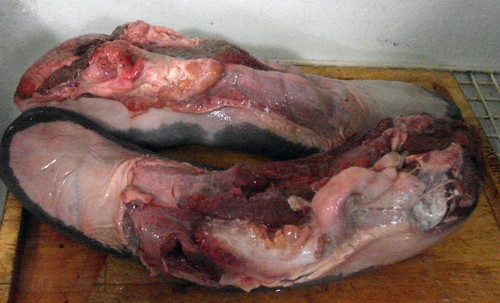

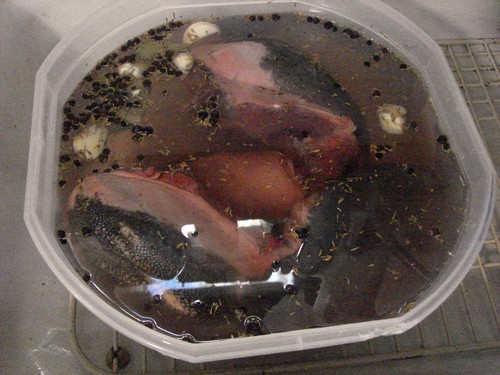
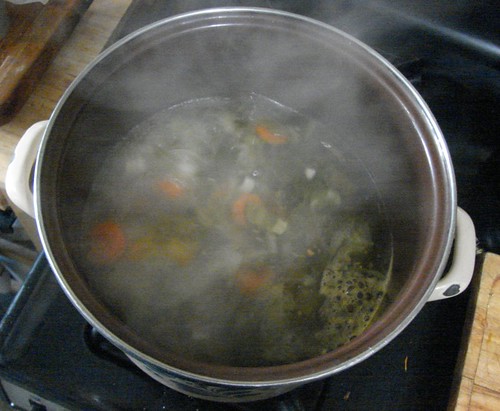
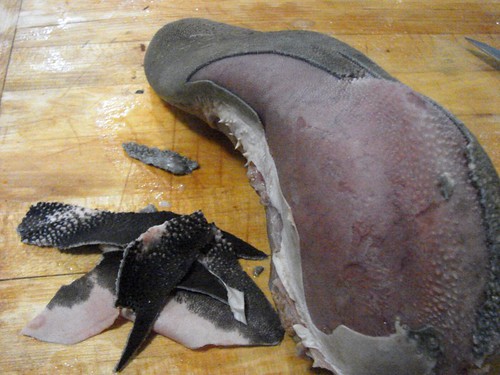
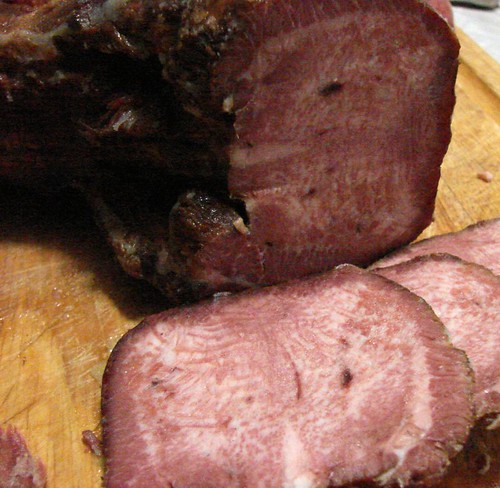
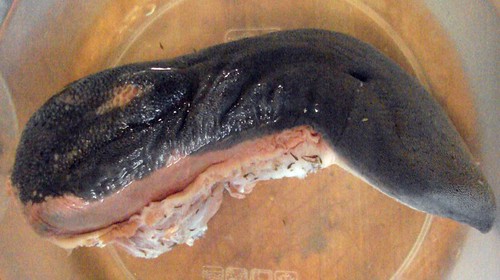
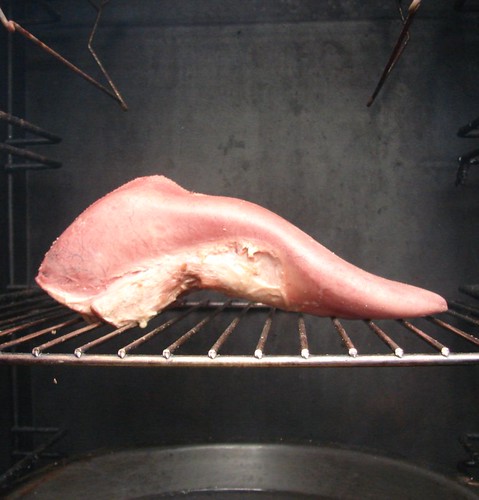
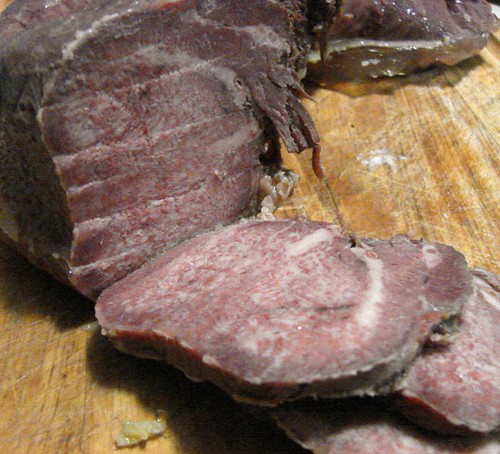
Nicely done. Looks as easy as ribs or a stuffed turkey. I can't wait to try it.
ReplyDeleteI've peeled back countless squirrel skull caps to get at the little soft nugget of cashew tasting brain, but I can't even bring myself to look at those beef tounges.
ReplyDeleteI actually have to look away from the squirrel skull until i can feel and smash the tounge. If i see the tounge I'm done for the day.
That is one thing that is gonna take some time to work up to... yecch!
ReplyDeleteYou guys should get together: http://www.thefoodinmybeard.com/2010/09/tacos-de-lengua-beef-tongue.html
Dave, you've made that look nearly edible. Bravo. I bet the dogs loved that skin, too!
ReplyDeleteI adore corned tongue...never had smoked...when I was younger, my mother used to make pickled lambs tongues...not sure what made them pickled, as I'm sure they weren't the ones I've seen in jars. All I need is some good hearty corn rye bread with seeds, good brown mustard and the tongue and I'm in heaven!!!
ReplyDeleteMy parents served a lot of organ meats as a kid. It was cheap but surprisingly good if introduced to it young enough. I loved smoked tongue which was locally available at the time. The fresh tongue wasn't as good. My favorite was calf brains which my mother would parboil and serve in scrambled eggs. Very tender with a sweet taste.
ReplyDelete